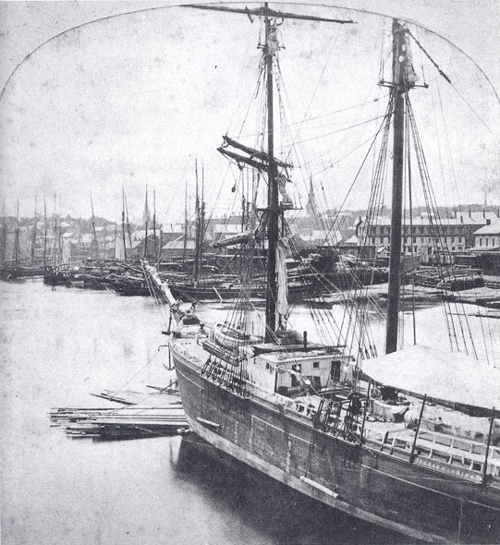B A C K T H E N
The Brigs of Bangor

Photo courtesy of Bangor Historical Society
1877. Bangor. The flush-decked half-brig Sarah M. Loring of Portland, built at Yarmouth in 1875, loads “deal” — heavy planking—through her bow ports. The ’70s, up to 1876 or ’77, were boom years for shipping deals to England and Ireland. A brig, however, would more likely be loading for the West Indies, to return to Portland or Boston with sugar or Turk’s Island salt. Beyond, schooners lie moored stern-to in “the tiers” off the Maine Central and City Point piers.
After the Civil War, the brig was rapidly replaced by the more economical schooner; by 1882 about 260 brigs remained under American registry. Of these, about 150 were Maine-built, and ninety were registered to Maine ports.
The Cuban sugar trade was long dominated by brigs, schooners, and small barks, as the lack of an adequate rail system kept the business in small ports and under sail. Brigs remained popular in tropical trades because their lofty squaresails found clean wind high above jungle river treetops. They were said to be the handiest of vessels, as willing to sail backwards as forwards when under skilled command. J. S. Winslow & Co. of Portland managed a number of brigs employed in this trade, including four built in 1874 by Giles Loring. Loring, who built and managed the Loring, specialized in West India traders. The Loring’s master in 1877 was Captain C. Loring. In 1892, Captain J. S. Winslow lamented the passing of the “speedy and easily handled” brig.
In January 1884, the Portland brig Don Jacinto left Boston with a cargo of Yankee notions—shoe pegs, tobacco, agricultural implements, nails, clocks, bicycles, hatchets, kerosene and so on—on a trading voyage to South America, Tasmania, Australia, and India. Another Maine brig leaving on a similar voyage was noted in the shipping news. In 1890, Farmingdale’s Captain J. H. Drew, upon arriving at Hong Kong, noted the Belfast brig H. C. Sibley lying at anchor—only a speculative trading venture could have brought so small a vessel so far.
Bangor also held to the brig. The fleet managed by T .J. Stewart long included brigs. In March 1888 the brig Harry Stewart sailed from Portland with a general cargo for Senegal, West Africa. Arriving in twenty-six days, she then proceeded to Turk’s Island for salt and arrived at New York on June 24, making a very speedy round trip in 101 days. The Bangor-built Telos, Captain Lawrence Coney, was a noted Mediterranean, West African, and West Indies trader. Built at Bangor in 1883, she would be the last American half-brig built:
A letter received here from Capt. Coney, of the new brig Telos, at Palermo, Sicily, from Bangor, states that the passage…was one of the hardest in his experience,the yards being on the backstays 59 out of 64 days passage—a dead beat to windward—while the other five days brought a gale. The barkentine C. S. Bushnell, of New Haven, also from Bangor, which sailed ten days before the Telos, was just twenty miles ahead of her into Palermo. When the Telos passed Gibraltar the Italian brig L’Amico, which had also sailed from Bangor about the same date, had not shown up. The Telos has proven to be a fine sailor, a first-class, nice working vessel in all respects, and she is a credit to the port of Bangor. She has gone from Palermo to Messina to load lemons, etc. for Boston. –The (Bangor) Industrial Journal, Mar. 7, 1884.
Between April 6 and November 26, 1880, arrivals at Bangor included six barks, seven barkentines, thirty brigs, 109 three-masted schooners, three four-masted schooners (the first ever to enter the port) and 1,655 two-masted schooners. Vessels moored along the city front were often so closely packed that the harbor master (or his assistant) could travel over-deck from the tip of City Point nearly to the Brewer Bridge. Vessels illegally anchored snagged lumber rafts and fenced the Boston steamer from its berth. Freshets always added interest. The harbor master and his assistant well earned their pay.
River water was fresh, and the steward of the Loring has rigged a line for the cabin’s laundry. Drying wash, drying sails, and the flags of foreign vessels created a carnival air. On some fine evenings, sailors gathered on deck to sing and make music; on others they battled—fights between British and “Dago” crews were especially bloody.
At Vincent Willard’s fruit store at the foot of Union Street, shipmasters gathered to smoke Cuban cigars, swap lies, and do business. Willard also “let” the lumber scows which were vital to the operation of the port. In 1877, after thirty-five years, Willard retired. The shop was then occupied by Captain Charles Lansil, harbor master, who had been a shipmaster for forty years and whose tales of adventures at sea could not be topped. If only some had been recorded!
Text by William H. Bunting from A Day’s Work, A Sampler of Historic Maine Photographs, 1860-1920, Part I. Published by Tilbury House Publishers, Gardiner, Maine, 800-582-1899
